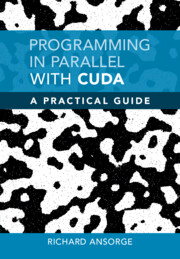Book contents
- Frontmatter
- Dedication
- Contents
- Figures
- Tables
- Examples
- Preface
- 1 Introduction to GPU Kernels and Hardware
- 2 Thinking and Coding in Parallel
- 3 Warps and Cooperative Groups
- 4 Parallel Stencils
- 5 Textures
- 6 Monte Carlo Applications
- 7 Concurrency Using CUDA Streams and Events
- 8 Application to PET Scanners
- 9 Scaling Up
- 10 Tools for Profiling and Debugging
- 11 Tensor Cores
- Appendix A A Brief History of CUDA
- Appendix B Atomic Operations
- Appendix C The NVCC Compiler
- Appendix D AVX and the Intel Compiler
- Appendix E Number Formats
- Appendix F CUDA Documentation and Libraries
- Appendix G The CX Header Files
- Appendix H AI and Python
- Appendix I Topics in C++
- Index
6 - Monte Carlo Applications
Published online by Cambridge University Press: 04 May 2022
- Frontmatter
- Dedication
- Contents
- Figures
- Tables
- Examples
- Preface
- 1 Introduction to GPU Kernels and Hardware
- 2 Thinking and Coding in Parallel
- 3 Warps and Cooperative Groups
- 4 Parallel Stencils
- 5 Textures
- 6 Monte Carlo Applications
- 7 Concurrency Using CUDA Streams and Events
- 8 Application to PET Scanners
- 9 Scaling Up
- 10 Tools for Profiling and Debugging
- 11 Tensor Cores
- Appendix A A Brief History of CUDA
- Appendix B Atomic Operations
- Appendix C The NVCC Compiler
- Appendix D AVX and the Intel Compiler
- Appendix E Number Formats
- Appendix F CUDA Documentation and Libraries
- Appendix G The CX Header Files
- Appendix H AI and Python
- Appendix I Topics in C++
- Index
Summary
Chapter 6 explains the CUDA random number generators provided by the cuRAND library. The CUDA XORWOW generator was found to be the fastest generator in the cuRAND library. The classic calculation of pi by generating random numbers inside a square is used as a test case for the various possibilities on both host CPU and the GPU. A kernel using separate generators for each thread is able to generate about1012 random numbers per second and is about 20 000 times faster than the simplest host CPU version running on a single core. The inverse transform method for generating random numbers from any distribution is explained. A 3D Ising model calculation is presented as a more interesting application of random numbers.The Ising example has a simple interactive GUI based on OpenCV.
- Type
- Chapter
- Information
- Programming in Parallel with CUDAA Practical Guide, pp. 178 - 208Publisher: Cambridge University PressPrint publication year: 2022

